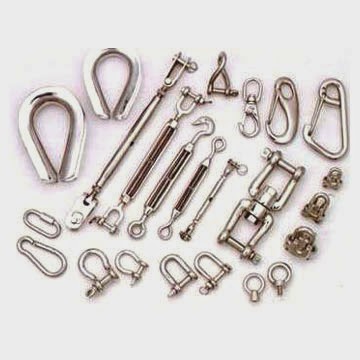Grade 431 of Martensitic Stainless Steel
Grade 431 of Martensitic Stainless Steel
This heat treatable martensitic, nickel-bearing grade has the best corrosion resistance properties of all the martensitic grades. It has excellent tensile and torque strength, and good toughness, making it ideally suited to shafting and bolt applications. It can be hardened to approximately 40HRC. Because of its high yield strength, this grade is not readily cold worked and is therefore not recommended for use in operations such as cold heading, bending, deep drawing or spinning. |
| Stainless steel Marine hardware |
Martensitic stainless steels are optimised for high hardness, and other properties are to some degree compromised. Fabrication must be by methods that allow for poor weldability and usually also allow for a final harden and temper heat treatment. Corrosion resistance is generally lower than the common austenitic grades, and their useful operating temperature range is limited by their loss of ductility at sub-zero temperatures and loss of strength by over-tempering at elevated temperatures.
Corrosion Resistance
Grade 431 has excellent resistance to a wide variety of corrosive media. Reasonable resistance to salt water in cold southern waters but is unlikely to be successful in warmer tropical waters. Overall the corrosion resistance of 431 is approximately the same as or slightly below that of Stainless Steel Grade 304.
Performance is best with a smooth surface finish, in the hardened and tempered condition.
Consult Atlas Technical Services for specific environmental recommendations.
Heat Resistance
Resists scaling in intermittent service to 925°C and in continuous service to 870°C, but is generally not recommended for use in temperatures above the relevant tempering temperature, because of reduction in mechanical properties.
Heat Treatment Annealing
Full anneal - not practical for this grade - it hardens even when cooled slowly.
Process Anneal - heat to 620-660°C and air cool.
Hardening
Hardened by heating to 980-1065°C, holding for about 1/2 hour then quenching in air or oil. Pre-heating at 760-790°C may be useful for complex parts or those already hardened. Temper to suit mechanical requirements, at temperatures as indicated in the accompanying table.
The tempering range 425-600°C should be avoided due to reduced impact toughness, although the effect is less marked than in most other martensitic grades.
Welding
Welding is difficult due to the risk of cracking. A pre-heat of 200-300°C is recommended prior to welding. Grade 410 filler rod can be used, but Grades 308L, 309 or 310 will provide more ductile welds, so long as matching properties are not required. Post-weld heat treat at 650°C.
Machining
In the annealed condition this grade is relatively easily machined, but if hardened to above 30HRC machining becomes more difficult. A Ugima Improved Machinability version of Grade 431 offers a significant improvement in achievable machining speeds and tool life.
Typical Applications
Nuts and bolts. Propeller shafting. Pump shafts. Beater bars. Marine hardware.
These properties are specified for bar product in ASTM A276. Similar but not necessarily identical properties are specified for other products such as plate and forgings in their respective specifications.
COLLECTION OF COMMON STAINLESS STEEL GRADE
Source:
http://www.atlassteels.co.nz/



.jpg)
.jpg)

.jpg)

.jpg)

0 comments :
Post a Comment